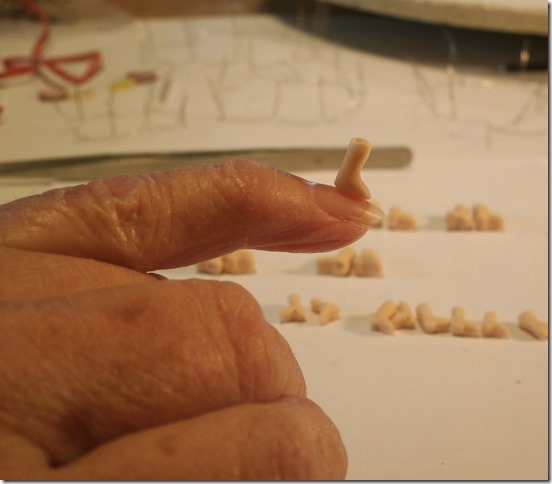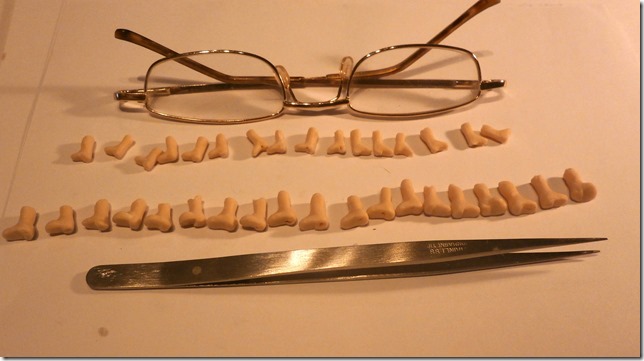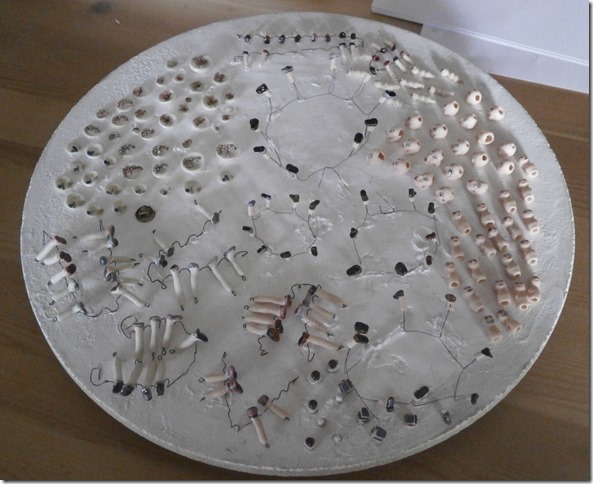The fact that I love all the dolls’ house scales is a fairly good indicator of my complete lack of financial acumen.
Dolls are very labour intensive, that is if you want to make a proper porcelain doll that you can really play with and which will last a few hundred years even when it’s under an inch and a half tall.
On my table there is a little box full of 48th scale moveable, bendy, porcelain dolls to dress. Each doll only costs £10, which is ludicrous when you consider the amount of work involved. The smaller the miniature, the greater the fiddle and the more the skill required in the making. I have to top up this box more than any other because any doll-loving miniaturist will sooner or later wonder if they could manage to dress a really small doll. I do also make jointed dolls, which are solid porcelain with a wire going through a hole in the body and out of a matching hole in the upper arms and thighs. These dolls are easier for me to make for numerous reasons. First, they are solid. To make a solid shape in a mould you need to keep injecting liquid clay until the mould is full up to the brim. Some shapes made this way can be a bit dodgy because they can create a hole in the middle as the plaster mould absorbs the water. If the shape is solid you cannot see the hole in the middle when the item is demoulded, the first you would know about it would be when the air in the centre expanded in the heat and the shape exploded in the kiln. The tiny doll, however, has to have a hole poked through the torso twice with a thin bit of wire, while it is still damp clay. Any surprise air in the middle has an escape route. The most difficult part is likely to be rubbing down thin porcelain limbs; if you don’t hold them carefully or rub too violently they will break, sure as broken eggs are smashed and cannot be mended. As always when I have broken three in a row I know this is nature’s way of telling me to stop making breaks and have one instead. On the whole (which we hope it is) the wastage rate is not too dreadful, if I pour ten dolls, which is fifty pieces of porcelain, I might get seven whole dolls at the end.
The 48th scale bendy dolls, however, which are much easier to dress because they can bend their arms and legs to help you, have to be hollow. This is tricky because the bits are rather small.
Either I’ve nailed it or there is something underhand afoot. This is indeed a 48th scale foot, you can just see the hole in the top. The hole must be big enough to admit a cloth-bound wire and some glue and plenty of both so that you can bend the leg back and forth without the wire coming out. Porcelain is a brilliant material for this because it is porous and drinks glue thirstily. The skill here is in the pouring. I have to pour a drip of slip into the mould and then, after a bit of counting, out again to leave a hollow shape. If some git comes to the door and I’m not fast enough on the outpour, the shape is solid and no good, I have to chuck it and start again. If I am too fast the shape is too thin to be rubbed down without collapse. As I pour the mould gets wetter and the time for the plaster to absorb the water changes.
But if I get it right and work for weeks, after the wastage, what I get out of the kiln is this.
There are three different sizes of 48th scale feet here, I’m going to need the glasses to sort them all out, or the poor dolls will have one big foot and one little one, which is seriously nit picking when you look at the first photo, but that’s 48th for you.
The tweezers are of use in the china painting phase. I do love china painting, it’s great, but the difficulty with pieces so small is how to stand them and where to hold them. China paint is a powder colour mixed with a medium. It remains wet until fired in the kiln when the porous porcelain surface absorbs and bonds with the paint. This is why you can scrub porcelain and why it will last hundreds of years unchanged. On the kiln shelf there is a thin layer of kiln sand, the job of which is to stop the porcelain paint bonding the painted object to the shelf forever. It is a sliding layer which is still sand, if a wetly painted porcelain piece falls into it, it will coat it with sand which will fire on there in the kiln. So the difficulty is to balance the tiny item on the sand without it falling over.
It took me a few years to come up with the answer.
Racks. For each firing I construct racks from thin wire that will survive in the kiln. Some of the racks are wiggly up and down, like a barbeque rack, I can prop the unpainted legs on these so the painted shoes are sticking up in the air. Some, those that appear to be rings, I have made like crowns with wire poking up in the air that I can balance the hollow legs on. The feat is precarious, and so are the feet, never more so than on the walk from the dining room table, round the corner, through the kitchen, up the step, along the corridor, into the garage and down into the kiln…
…and breathe.
It has taken a week to china paint the contents of that round kiln shelf. It has taken many years to know not just to plough on when I am tired.
My style of miniatures has always been the style I first fell in love with in eighteenth century cupboard houses. The child-like innocence and optimism that first captivated me and made me want to have a go is what I still strive for. I love the house being the place where the dolls live. I can see where miniaturists who wish to make high art or emulate reality to a great degree are coming from, whether they strive to miniaturise perfection or imperfection in reality. You’ll never find me devising ways to make miniature coffee stains, or agonising over my drawer handle being insufficiently Chippendale.
I like miniatures to be a happy regression to a time when life was simpler, I like the miniaturists to be able to call the shots and not be wrong and I like everyone to be able to afford something that has the potential to be an heirloom.
If you do too, I’ll see you at the show, 16th and 17th March details as always at www.miniatura.co.uk
~~~~~~~~~~~~



